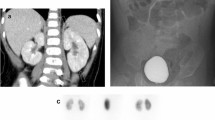Abstract
Background
The detection of renal scars is of paramount importance for optimal clinical management of patients with urinary tract infection (UTI) and vesicoureteral reflux (VUR). The aim of our study was to compare the efficacy of unenhanced magnetic resonance urography (MRU) and Tc-99m dimercaptosuccinic acid (Tc-DMSA) scintigraphy to dectect renal scars.
Methods
Unenhanced MRU and Tc-DMSA scintigraphy were performed in 49 children (10 boys, 39 girls; mean age 7.4 ± 4.2 years, range 1–15 years) with documented VUR. MR imaging scans were obtained within 7 days after voiding cystourethrogram (VCUG) and Tc-DMSA scintigraphy. The diagnostic performance of MRU in renal scar detection was calculated relative to that of the Tc-DMSA scan.
Results
The renal scar detection rate of Tc-DMSA scintigraphy and unenhanced MRU in kidneys with VUR was 32.4 and 25.9 %, respectively. The sensitivity and specificity of MRU in the detection of renal scars was 80 and 82.6 % in kidneys with VUR, respectively. There was no statistically significant difference in lesion detection between MRU and Tc-DMSA scintigraphy (P > 0.05). MRU and Tc-DMSA scintigraphy showed good agreement (κ = 0.60).
Conclusions
Unenhanced MRU is a robust technique for the morphologic assessment of the urinary system and detection of renal scars. The lack of radiation and contrast material makes this technique a much safer alternative to scintigraphy in children with VUR, particularly in those who require follow-up scanning and, consequently, considerable radiation exposure.



Similar content being viewed by others
References
Stefanidis CJ, Siomou E (2007) Imaging strategies for vesicoureteral reflux diagnosis. Pediatr Nephrol 22:937–947
Orellana P, Baquedano P, Rangarajan V, Zhao JH, Eng ND, Fettich J, Chaiwatanarat T, Sonmezoglu K, Kumar D, Park YH, Samuel AM, Sixt R, Bhatnagar V, Padhy AK (2004) Relationship between acute pyelonephritis, renal scarring, and vesicoureteral reflux. Results of a coordinated research project. Pediatr Nephrol 19:1122–1126
Polito C, Rambaldi PF, Signoriello G, Mansi L, La Manna A (2006) Permanent renal parenchymal defects after febrile UTI are closely associated with vesicoureteric reflux. Pediatr Nephrol 21:521–526
MacKenzie JR (1996) A review of renal scarring in children. Nucl Med Commun 17:176–190
Kovanlikaya A, Okkay N, Cakmakci H, Ozdoğan O, Degirmenci B, Kavukcu S (2004) Comparison of MRI and renal cortical scintigraphy findings in childhood acute pyelonephritis: preliminary experience. Eur J Radiol 49:76–80
White GW, Gibby WA, Tweedle MF (2006) Comparison of Gd (DTPA-BMA) (Omniscan) versus Gd (HP-DO3A) (ProHance) relative to gadolinium retention in human bone tissue by inductively coupled plasma mass spectroscopy. Invest Radiol 41:272–278
[No authors listed] (1981) Medical versus surgical treatment of primary vesicoureteral reflux: report of the International Reflux Study Committee. Pediatrics 67:392–400
Grattan-Smith JD, Jones RA (2006) MR urography in children. Pediatr Radiol 36:1119–1132
Verswijvel GA, Oyen RH, Van Poppel HP, Goethuys H, Maes B, Vaninbrouckx J, Bosmans H, Marchal G (2000) Magnetic resonance imaging in the assessment of urologic disease: an all-in-one approach. Eur Radiol 10:1614–1619
Garin EH, Campos A, Homsy Y (1998) Primary vesicoureteral reflux: review of current concepts. Pediatr Nephrol 12:249–256
Yeung CK, Godley ML, Dhillon HK, Gordon I, Duffy PG, Ransley PG (1997) The characteristics of primary vesico-ureteric reflux in male and female infants with pre-natal hydronephrosis. Br J Urol 80:319–327
Lee JH, Son CH, Lee MS, Park YS (2006) Vesicoureteral reflux increases the risk of renal scars: a study of unilateral reflux. Pediatr Nephrol 21:1281–1284
Chan YL, Chan KW, Yeung CK, Roebuck DJ, Chu WC, Lee KH, Metreweli C (1999) Potential utility of MRI in the evaluation of children at risk of renal scarring. Pediatr Radiol 29:856–862
Kavanagh EC, Ryan S, Awan A, McCourbrey S, O’Connor R, Donoghue V (2005) Can MRI replace DMSA in the detection of renal parenchymal defects in children with urinary tract infections? Pediatr Radiol 35:275–281
Thomsen HS (2008) Is NSF only the tip of the “gadolinium toxicity” iceberg? J Magn Reson Imaging 28:284–286
Tweedle MF, Wedeking P, Kumar K (1995) Biodistribution of radiolabeled formulated gadopentetate, gadoteridol, gadoterate and gadodiamide in mice and rats. Invest Radiol 30:372–380
Author information
Authors and Affiliations
Corresponding author
Rights and permissions
About this article
Cite this article
Koçyiğit, A., Yüksel, S., Bayram, R. et al. Efficacy of magnetic resonance urography in detecting renal scars in children with vesicoureteral reflux. Pediatr Nephrol 29, 1215–1220 (2014). https://doi.org/10.1007/s00467-014-2766-y
Received:
Revised:
Accepted:
Published:
Issue Date:
DOI: https://doi.org/10.1007/s00467-014-2766-y




